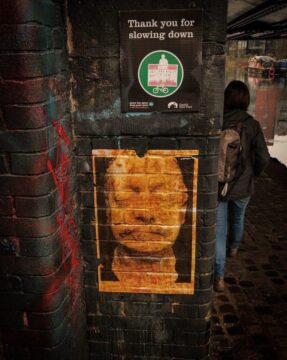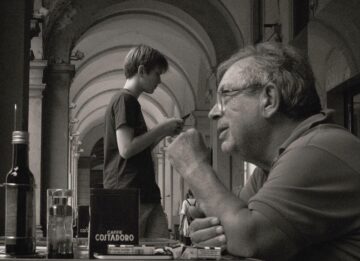by Christopher Horner
Immediacy itself is essentially mediated —Hegel

Look at that desk in front of you right here, now. Isn’t it just there, a bare existence, a simple immediate thing right in front of you? The senses register its presence. This, at least, is a bare fact that you know.
But look again at the desk in front of you. What is it you are aware of? A desk: not a carpet or a parrot, its colour (brown), its shape (rectangular), all that is that negates what might have been (it isn’t grey, it isn’t circular, etc). Your awareness of the desk is mediated by concepts and you, a language user, can only make sense of the thing through those concepts, the universal terms that enable you to pick out this thing here, now. And you are aware of it now as you were 5 minutes ago, although the light has changed and you, a namable person, not a disembodied spirit, have shifted your position on your chair to look back at the clock on the wall. Time, place, objects: everything is mediated: that is, nothing is simply ‘there’ in splendid isolation to be passively registered by your senses.[1]
 Consider again the wooden desk. It was once part of a tree, like the ones outside your window. It became a bit of furniture though a long process of growth, cutting, shaping buying and selling until it got to you. You sit before it as it has a use – a use value – but it was made, not to give you a platform for your coffee or laptop, but in order to make a profit: it has an exchange value, and so had a price. It is a commodity, the product of an entire economic system, capitalism, that got it to you. Someone laboured to make it and someone else, probably, profited by its sale. It has a history, a backstory.
Consider again the wooden desk. It was once part of a tree, like the ones outside your window. It became a bit of furniture though a long process of growth, cutting, shaping buying and selling until it got to you. You sit before it as it has a use – a use value – but it was made, not to give you a platform for your coffee or laptop, but in order to make a profit: it has an exchange value, and so had a price. It is a commodity, the product of an entire economic system, capitalism, that got it to you. Someone laboured to make it and someone else, probably, profited by its sale. It has a history, a backstory.
 All of this is the case, but none of it simply appears to the senses. Capitalism itself isn’t a thing, but that doesn’t make it less real. The idea that all that there really is amounts to things you can bump into or drop on your foot is the ‘common sense’ that operates as the ideology of everyday life: “this is your world and these are the facts”. But really, nothing is like that: there are no isolated facts, but rather a complex, twisted web of mediations: connections and negations that transform over time.
All of this is the case, but none of it simply appears to the senses. Capitalism itself isn’t a thing, but that doesn’t make it less real. The idea that all that there really is amounts to things you can bump into or drop on your foot is the ‘common sense’ that operates as the ideology of everyday life: “this is your world and these are the facts”. But really, nothing is like that: there are no isolated facts, but rather a complex, twisted web of mediations: connections and negations that transform over time.
This doesn’t mean that the way things show up for us is somehow false, an illusion that masks a hidden essence. The essence of a thing is reflected in the way it appears, in the connections and negations with everything else, and in the way in which it develops over time. Slavoj Zizek makes the point in a discussion of Hegel’s view of the matter:
[…] the inner potentials of the self development of an object and the pressure exerted on it by an external force are strictly correlative; they form the two parts of the same conjunction. In other words the potentiality of the object must also be present in its external actuality […]. For example…to say that a pupil at the beginning of the process of education is somebody who potentially knows, somebody who, in the course of his development, will realise his creative potentials, equals saying that these inner potentials must be present from the very beginning in external actuality as the authority of the Master who exerts pressure upon his pupil.[….] external circumstances are not an impediment to realising inner potentials, but on the contrary, the very arena in which the true nature of these inner potentials is to be tested: are such potentials true potentials or just vain illusions about what might have happened? [2]
 ‘External circumstances’ are where the essence of a thing appears. Think of the four Beatles: are we to suppose that their amazing talent was simply a matter of a innate ability that would push through and show itself, ‘against the world’? Surely the condition for the career of the Fab Four includes the art school scene of the day, the economic and social possibilities in Liverpool and Britain in the 1950s and 60s. ‘The Beatles’ occur because of the world in which they grew up, not despite it. The inner (‘talent’, ‘potential’) is inseparable from the outer (‘external conditions’).
‘External circumstances’ are where the essence of a thing appears. Think of the four Beatles: are we to suppose that their amazing talent was simply a matter of a innate ability that would push through and show itself, ‘against the world’? Surely the condition for the career of the Fab Four includes the art school scene of the day, the economic and social possibilities in Liverpool and Britain in the 1950s and 60s. ‘The Beatles’ occur because of the world in which they grew up, not despite it. The inner (‘talent’, ‘potential’) is inseparable from the outer (‘external conditions’).
 And if one of the ways we can approach these mediations is through theory, the other is through art. Art is in the world in which we come to know ourselves and is a way of coming to that knowledge. The paintings of Cezanne, the installations of Anselm Kiefer, the novels of Joyce and the music of Ligeti, all vibrate to the interrelatedness, dynamism, negation and connection between times, places and people. The very ‘difficulty’ in the way modern art often communicates tears us away from the quotidian, the ‘common sense’ of everyday life. Art makes it strange in order to make it true, unveiling ways of seeing, and ways of going beyond what lies in immediately before us. Art can reveal mediation because it is a mediation itself. It is always transitive, always going somewhere, linking now to then and here to there, showing how ‘essence must appear,’ in the ways things appear, in how they change and in what we do. And in doing that it reveals how we too might change that world.
And if one of the ways we can approach these mediations is through theory, the other is through art. Art is in the world in which we come to know ourselves and is a way of coming to that knowledge. The paintings of Cezanne, the installations of Anselm Kiefer, the novels of Joyce and the music of Ligeti, all vibrate to the interrelatedness, dynamism, negation and connection between times, places and people. The very ‘difficulty’ in the way modern art often communicates tears us away from the quotidian, the ‘common sense’ of everyday life. Art makes it strange in order to make it true, unveiling ways of seeing, and ways of going beyond what lies in immediately before us. Art can reveal mediation because it is a mediation itself. It is always transitive, always going somewhere, linking now to then and here to there, showing how ‘essence must appear,’ in the ways things appear, in how they change and in what we do. And in doing that it reveals how we too might change that world.
[1] We might add that modern physics tells us that ‘simple experience’ isn’t a sound guide to reality of desks or anything else: what appears to me as a solid thing I can place my coffee cup on, is actually a mass of charged particles with more space than solidity ‘in the table’, not to mention the strangeness of quantum mechanics to consider.
[2] Slavoj Zizek, Tarrying with the Negative: Kant, Hegel and the Critique of Ideology. (Duke University Press, 1993, pp 142)
